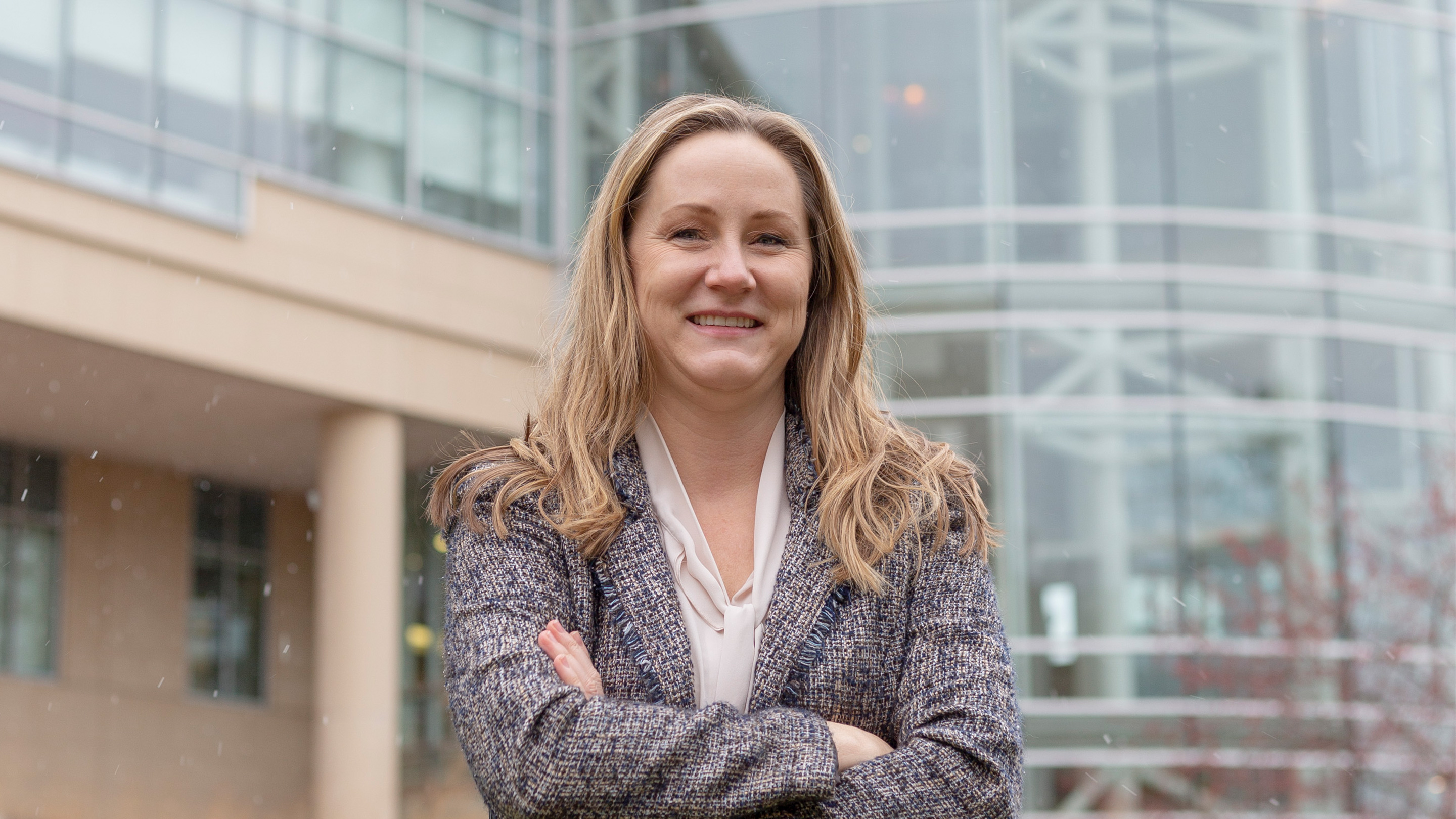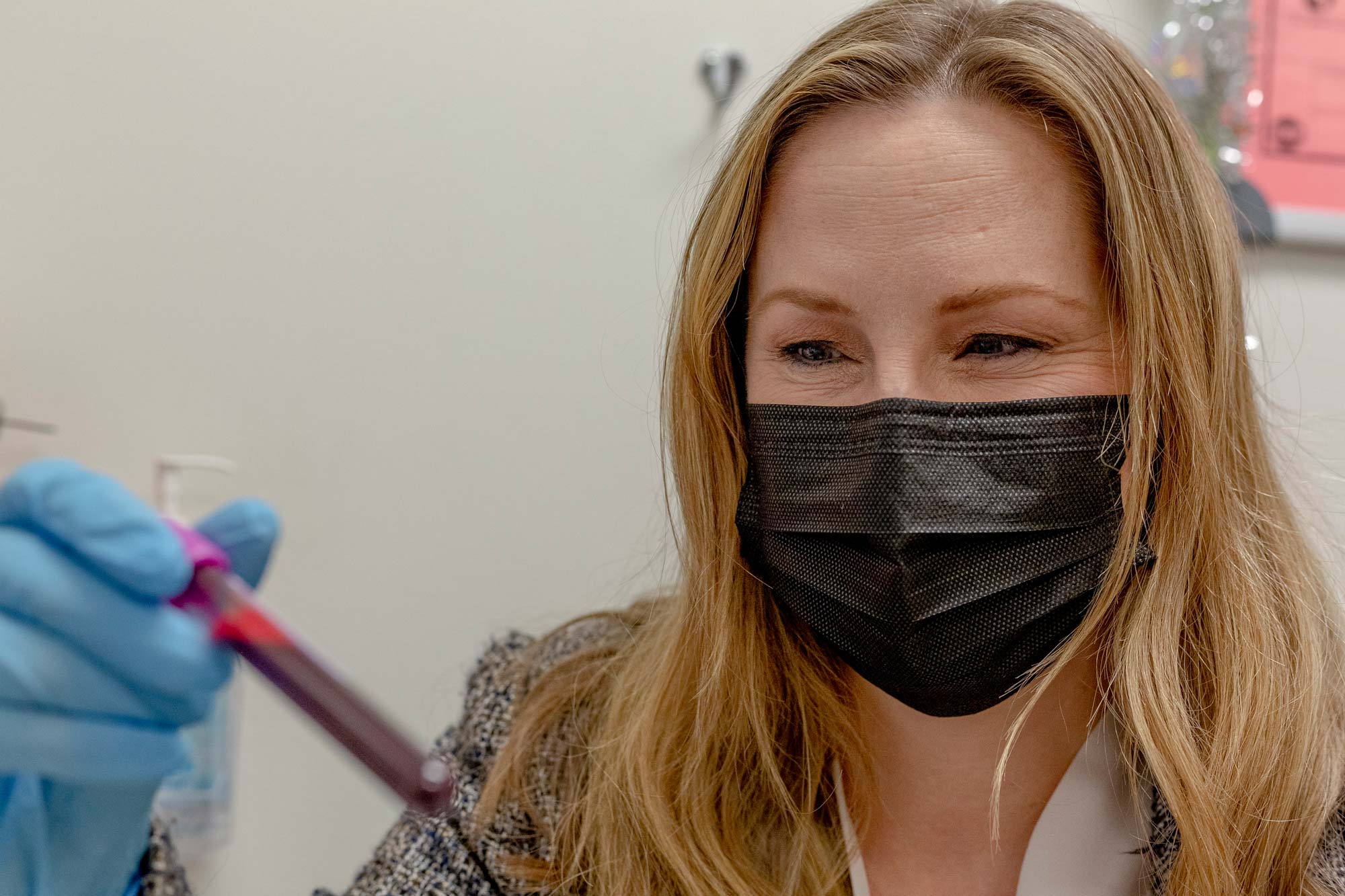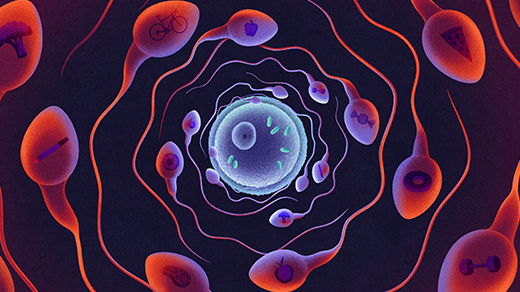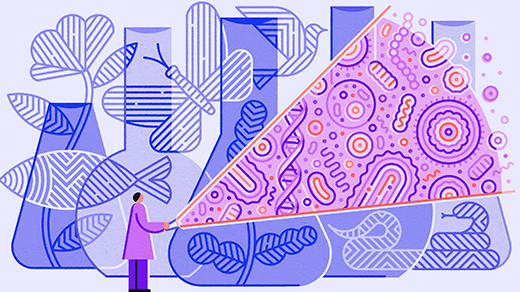When a Gene Illness Discovery Means Breaking Bad News

Cristen Willer, a professor of cardiovascular medicine at the University of Michigan, sought genetic markers that might identify people at risk for a deadly heart condition. But finding those markers created its own bioethical challenges.
Sylvia Jarrus for Quanta Magazine
Introduction
Back in 2020, Cristen Willer, a professor of cardiovascular medicine at the University of Michigan in Ann Arbor, was leading her laboratory on a search for the genetic underpinnings of an often deadly heart condition called aortic dissection. As the results came in, she was troubled by some of the answers she was getting. They were quite clear — but they had the potential both to help and hurt some patients who had volunteered for the study and their families.
Willer and her team had hoped to discover genetic variants associated with the condition that could affect a patient’s diagnosis and care, and they had. Nearly 11% of the aortic-dissection patients in their study carried variants of genes that correlated with the pathology. Even 10% is considered quite high when it’s associated with conditions (such as Type 2 diabetes) that have a clear genetic component, Willer explained, so the finding was significant.
But it also plunged the researchers into a quandary. They were looking at genetic information from people who had contributed to a biorepository (or biobank) for general research purposes, not with any guarantee of being alerted to medical problems they or their relatives might face.
Willer and her team needed to devise an effective and ethical way to notify the research participants about their genetic variants while preserving their “right to not know” about the harmful aberrations. And the clock was ticking, because if patients did want to act on the information, speed could be crucial in getting the right medical care to them or their descendants.
Willer’s work set a precedent for handling similar issues of disclosure stemming from genetic discoveries made in samples from biobanks, which could become increasingly common as genomic medical research continues to take off.
Willer’s passion for genetics began during a high school internship at a children’s hospital in Canada, where she grew up. “The first time I saw DNA form in a test tube — it’s clear liquid and you shake the test tube back and forth and the DNA strands just, like, magically appear — I thought it was so incredibly fascinating that this kind of secret language was inside all of our cells, giving all the instructions,” she said. “I was very interested in deciphering that code.”
She went on to study genetics in college. Then, while she was in graduate school, her research laboratory at the University of Western Ontario moved to the University of Oxford. During the downtime that resulted from making that logistically challenging move, her focus expanded to include genetic epidemiology. Once Willer realized the critical role that statistical analysis could play in making sense of her data, she refocused her studies and completed what she calls a “longer-than-average” postdoctoral fellowship in biostatistics at the University of Michigan.
Willer was awarded the 2021 Early-Career Award from the American Society of Human Genetics. “She has demonstrated an ability to tackle big questions and has an abiding commitment to improving human health,” Gail Jarvik, president of the ASHG, noted in the award statement. “This award honors her as an outstanding and remarkably productive scientist and dedicated educator and mentor who is already a world-leading researcher in cardiovascular genetics.”
Willer spoke with Quanta about how she and her team designed and implemented a protocol for disclosing thorny findings to patients and about the need to tackle diversity issues in biorepository samples. The interview has been condensed and edited for clarity.
Let’s start with the basics. What is an aortic dissection?
The major blood vessel leading away from your heart to circulate blood through the rest of your body is the aorta. Unfortunately, in some people, the aorta can develop tears or even rupture, which is immediately life-threatening. So in some people over the age of 65 or who have a family history of aortic dissection, cardiologists monitor the diameter of the aorta over time, and if it’s starting to increase, they do surgery to repair that section of the aorta. There are no good treatment options other than surgery. If the surgery happens too late, or if the widening of the aorta is never caught, the dissection just happens out of nowhere, and it’s a catastrophic event.
Because there are families with histories of aortic dissection, have researchers suspected that this condition has a genetic component for a long time?
Yes, but the genetic factors are complicated. It’s hard to identify all of the genetic factors from a single family or just a few families.
How did you get involved in studying genetic variants associated with aortic dissections?
The University of Michigan treats a lot of patients with aortic disease, and that creates an opportunity to involve these patients as participants in research to help others who may develop this condition in the future. We have collected one of the world’s most useful biobanks for studying aortic dissection and aortic disease.
For the 10% of patients with a genetic variant that you detected, what was the nature of those differences? Was there an existing process for sharing this information that they were at elevated risk?
Our research lab could pinpoint a single genetic change — one tiny difference in their DNA — that caused their disease. There wasn’t a system at the University of Michigan to provide that result back to the patient in this situation, because it was a research test and not a test that qualifies as a clinical test under FDA requirements.

Willer founded the Michigan Racial Equality and Community Health (MREACH) project to expand the diversity of people contributing genetic samples to “biobank” repositories for research.
Sylvia Jarrus for Quanta Magazine
How does clinical-grade testing go beyond research-grade testing?
It’s mostly related to the processes in the lab. Basically, in clinical research, there are bar code-labeled sample tubes that get checked and double-checked in multiple places, so we can be confident that a genetic result belongs to the patient we think it belongs to. That process, because it’s much more careful and may involve running samples in smaller batches, is simply more expensive, so research studies typically don’t pay for it.
So there’s that difference. But even with clinical standards, there’s also always an element of imperfection in understanding genetic results.
What do you mean?
Maybe you’re completely sure that a certain genetic change exists in a patient. But every human has a bunch of genetic changes that might be specific to themselves, their family or their ancestry. Interpreting which variants absolutely cause disease or increase the risk of disease is the hard part of what we do as geneticists.
What was required for you to show with high confidence that the pathogenic variants were linked to aortic dissection in study participants?
After we found thousands of genetic variants associated with aortic dissection, we let other researchers independently evaluate their significance. We contracted with other laboratories, including one at the University of Texas, to assess whether those variants were likely to be causing disease. And one of the world’s leading physician-scientists studying aortic dissection made the call for us about whether the variants were pathogenic or not from a blind review of all the data, from both the variants and control cases.
What they sent back to us out of the thousands of variants we sent them was a list of only 26 that they considered pathogenic or likely to cause disease. When we then went back to the case data, we saw that all 26 of the people carrying those pathogenic variants were aortic dissection cases. None of the healthy controls in the study carried these genetic changes. That reassured us that the conclusions were correct.
What are some of the ethical considerations that went into the decision to notify the patients?
There was a lot of discussion about potential risks and benefits to the patients. There’s a clear benefit, of course, if the information about the variant means they can get more timely treatment or head off a recurrence of the problem. The physicians treating the patient could consider performing the surgery sooner. They might monitor the aortic diameter more frequently or more closely. They could also suggest more specific counseling for reducing any behavioral or lifestyle risk factors.
We wanted to make sure that there was something the patient could act on based on this information to reduce the risk, that it would change their clinical care for the better.
But we also had to consider whether returning this result would cause patients a great deal of stress and whether this news might affect their ability to have health care insurance, long-term disability or life insurance. We had to consider whether people might feel there was nothing they could do with this information — that they were just predetermined to get a disease. We felt it was important to reduce those risks as much as possible.
And of course, genetic information like this is also relevant to the research participant’s family members, since some of them may be carrying the same variant. How might the news change treatment options for them?
Some of the research participants already knew they had a family member who died suddenly in their 30s or 40s from some heart condition, but they didn’t necessarily know the details. Given this new genetic information, it becomes much more likely that person died of an aortic dissection. By identifying the specific genetic change associated with that problem, it’s possible to then screen the participant’s children or perhaps grandchildren to see if they carry the variants. Those individuals can be followed much more closely in the clinic or even have surgery earlier in life to repair their aorta.
Once you knew you had critical information to share with the biobank participants, what did you do?
We worked with our ethics board at the University of Michigan to develop a procedure for notifying the participants that we found a genetic change that causes this disease.
Then you notified the participants.
We sent the information by letter, but we decided not to reveal the specific genetic change in the letter. We just said, “We found some information that we think will be important to your medical care. Please contact this genetic counselor to make an appointment, and she will explain it all to you.”
Why did you send letters instead of communicating electronically?
Many of our aortic clinic patients are older, and the results of previous surveys indicated that they preferred letters over emails and messages on the web portal. But we also opted to send the letter by certified mail, so we knew exactly when it was delivered.
Why was it important to keep the findings shared in that letter relatively vague?
We didn’t want the recipients to be getting a letter in the mail with some potentially scary medical information in it and then Googling the gene while not necessarily understanding that this was a research result, not a clinical test.
As you study other genetic variants, are you evaluating options for giving patients a choice in advance about what type of information they would like to receive in the letters mailed to them if pathogenic variants are found?
Absolutely. I think the more that patients decide what information they want to receive and how to receive it, the better.
Was the letter the end of your team’s involvement with the biobank participants?
No, we followed up within a week with a phone call from a genetic counselor to say, “We sent you this letter and wondered if you had questions. We’re happy to schedule the appointment for genetic counseling.”
Again, we tried to mitigate the risk of undue stress on the research participant by following up with that phone call and a timely appointment. The genetic counselor had blocked off appointments in her calendar for the week or two immediately after the letters went out. We didn’t feel it was fair to send a letter and say, “Come and meet our genetic counselor. But oh, by the way, we don’t have appointments.” We didn’t want expense to be an issue either, so our research program covered the costs for the genetic counseling and clinical testing that came out of this.
How is your protocol for disclosing similar information evolving?
We now ask every participant when they enter a study, “If we find something in your DNA that we think will impact your clinical care, would you like to be informed?” Then we only contact those specific people who said yes.
Have researchers at other universities or research centers gone through a similar process for disclosing genetic information from their studies?
Yes, several institutions are disclosing genetic information. Geisinger Health System is one of the leaders in this area. The Mount Sinai medical school is also returning results to patients in certain cases. However, most institutions are returning results that are from a clinical-grade test. The more challenging ethical situation is if you have genetic information on a patient, but it’s only at a research level of accuracy, which typically wouldn’t go back to the research participant.
Do you hope that the approach you use might serve as a starting point for other researchers who discover similar information and need to decide what to do with it?
That was our goal. We even provided the wording of the letters that we sent in our scientific manuscripts.
What is the Michigan Racial Equality and Community Health (MREACH) project, and why is it important to you?
As researchers, we’re motivated to help other people, so it’s a very uncomfortable feeling if we’re systematically helping only a certain group. There’s a historical legacy of unfairness in research, particularly surrounding race, and of science taking advantage of people participating in studies. We wanted to ensure our research was conducted more ethically as we move forward.
One way I could make a difference was to make sure that different groups are represented in our research studies, because we can’t understand how different genetic variants might predispose different groups of people to disease if we’re not studying those people. If we want to understand the risk factors that predict heart attacks, for example, which might be quite different between men and women, then we can’t even ask that question if we don’t have enough women with heart disease enrolled in our studies. We also wanted to ensure we had representation of individuals with diverse genetic ancestry.
But because of past harms, some Black Americans are naturally and unsurprisingly more hesitant to participate in research studies. Unfortunately, the price paid today for this is that we can’t, for example, predict and prevent diseases as well in those populations that are underrepresented in our research. I founded and direct MREACH, and pay for it from my faculty research funds, because we wanted to recruit these individuals for studies conscientiously and actively, to ensure that our research benefits all people more equitably.
How did you progress from this vision of creating a more diverse biobank to getting buy-in from the potential participants?
A major step was building trust by being more transparent about our research, making sure that the results are conveyed to the people that we’re trying to help. Even just creating newsletters that go to participants and having more dialogue helps.
Also, trying to reduce the burden on people for joining a research study was important. That is, reducing the time required to participate, and making the infrastructure as convenient as possible for participants who are donating their time and own blood sample information. Those kinds of obstacles can screen out historically marginalized people more.
What are some practical ways you have done that?
Talking to people about the study — answering all their questions, taking time to do that properly while they’re waiting to see their doctor — is a much better use of that research participant’s time than trying to talk to them at the very end of their appointment when they’re tired, they want to go home, or they need to get back to work. Also, trying to recruit patients in the clinic where they’re from. We looked very carefully at the demographics of patients seen in each of our medical centers and tried to deploy our consent team — the ones talking to the patients to make sure they could give informed consent — to meet the patients where they are.
We also were very fortunate to work with Kenneth Jamerson, a physician who has done a lot of research in this area and has a wonderful bedside manner, to help design the research study to be as protective of patients’ confidentiality as possible. Basically, every person in the study gets anonymized behind a research ID. People must go through many approval processes to see any identifying information about that patient. The majority of our research is done with coded information and without any knowledge of who a specific patient is. I’m the principal investigator of the study, and even I almost never see any kind of identifying information about a patient.



